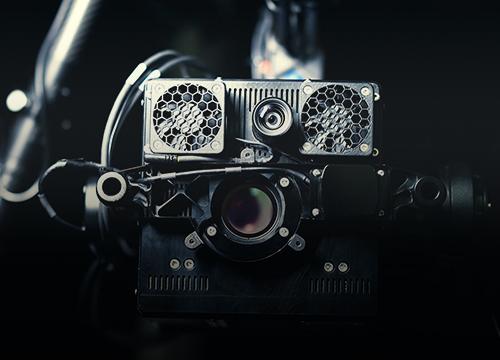Optical coherence tomography (OCT), a significant spectroscopy technique, has been used in biomedical applications for about 20 years. It has evolved to a standard non-invasive examination procedure yielding detail-rich cross-sectional images of living tissue. With longer wavelengths in the IR spectrum and the availability of InGaAs detectors and cameras, OCT scanners now penetrate even deeper into human tissue. This article presents technical improvements on an IR line-scan camera which specifically benefits OCT applications.
OCT performance and its suitability for biomedical uses, especially in the near infrared realm, are largely determined by detector technology and camera design. Now expanding to the short-wave infrared (SWIR), or near-infrared (NIR) spectrum, OCT applies an illumination beam of a wavelength around 1300 nm to penetrate opaque tissue at a depth of up to several millimeters enabling a spatial resolution in the micrometer range. Deployed as a dermatology or dentistry diagnosis tool, OCT takes cross-sectional images of lower, hidden layers of living tissue without physical contact or surgically invasive procedures. It is, for example, a perfect tool to be integrated in medical systems for early skin cancer detection. Wavelengths are only restricted by the absorption barrier caused by the water content of tissue at around 1400 nm, which limits the application of any IR analysis tool in this wavelength region.
The impact of OCT imaging on established medical procedures is expected to grow significantly. This in turn will change current practices, such as the early detection of a cancerous growth.
Basic principles of OCT
As a high-frequency electromagnetic equivalent of ultrasound probing techniques, OCT delivers images of high resolution – well into the micrometer regime. The penetration depth is dependent on the material to be examined, and the wavelength used. In the infrared spectrum, OCT penetration depth can easily reach more than 6 mm for human tissue inspection. As a consequence, OCT is able to bridge the realms of confocal microscopy and ultrasound, as well as other computer tomography (CT) methods such as magnetic resonance imaging (MRI) (figure 1).
The principle of this imaging technique in the frequency domain is delineated in figure 2. Fourier transform OCT is an interferometric method that uses spectrometric information, which is obtained from the interference of two white light rays (generated by a single high-brightness LED with short coherence length or a pulsed laser), one of them being reflected by the tissue to be examined.
Interference between the direct ray from the light source and the second ray reflected by the object through a semi-transmissive mirror (or beam splitter), delivers a spectral response, which is captured by a high-density, line-array or 2D detector with high sensitivity.
The sensor signal contains spectrally encoded information about the examined layer composition. A subsequent Fourier transform of the spectral data delivers a spatial distribution pattern. This yields to images structured as a sequence of single layers, much like tissue slices under a microscope, which show cross-sectional optical reconstructions of the deeper layers of the test object.
Technical improvements for OCT application
For the detection of (short-wave) near-infrared spectral signals classical CMOS or CCD image sensors are not sufficient since their sensitivity is limited to the visible spectrum. Significantly higher SWIR sensitivity is achieved with sensors in InGaAs technology.
One of the latest InGaAs line cameras offer a linear 2,048 pixel array with one inch length, arranged in a 12.5 µm x 12.5 µm pixel format. The higher resolution of the camera sensor is extending the range of OCT towards higher spatial resolution applications. Figure 4 offers a glimpse at the interior of the otherwise hermetically sealed package of the InGaAs sensor, which is fitted with a clear window. To the right there is a detailed view of the connection of the sensor line with its two read-out integrated circuits (ROICs) fitted.
High-resolution sensor for biomedical applications
The new camera contains a linear InGaAs detector array with specifically designed CMOS read-out circuitry. The tight connection and closeness between sensor and ROICs combines the advantages of the two technologies. First, the sensitivity of the InGaAs sensor extends well into the NIR (SWIR) covering wavelengths between 0.9 µm and 1.7 µm. This is far beyond the reach of CMOS and CCD. Second, since laid out in CMOS technology, the ROIC optimizes the analog signal pre-processing by complementing it with integrated digital functionality.
The actual focus in camera development is on high-resolution line-scan and 2D cameras and detectors for the short-wave (SWIR) region. This suits the targeted biomedical applications such as ophthalmology, dermatology, and dentistry.
Specifically in biomedical applications there are two further considerations: First, the light has to penetrate the tissue as deep as possible. Second, since measurement and image capture are based on spectrometric interference, speed and spectral resolution are required to obtain an excellent depth resolution combined with sensor speed for the surface resolution. Sensor or system speed is a must for surface scanning at reasonable acquisition times, an high spectral resolution is required to allow carefull examination of small features in the tissue to be examined.
In this sense the optical resolution of 12.5 µm is an optimum because it matches the pixel pitch of the sensor array. It improves the resolution of the interference patterns that are being mapped. Thus, next to the appropriate short IR wavelength (SWIR) of the illumination source there is the need to preserve all the data that contain the depth information, which is given by the pixel pitch.
All these factors taken together, including the speed of the scan, will make the final resolution of the resulting diagnostic image. In sum, there is an optimum combination of wavelength (to penetrate deeply into the tissue), pixel pitch (delivering the depth profile), and scan speed (determining resolution).
Besides that, the high line rates of up to 40 kHz yields to high resolution in the time domain. In many cases, this leaves sufficient resources for multiple sampling, thereby increasing the dynamic range.
The small outline of the InGaAs sensor also leads to lower-cost optics at the same field of view. It enables a greater variety in available lenses. The sensor’s short overall length makes it configurable in one single detector array. It distributes its 2048 smaller pixels (12.5 µm pitch) over an array length that usually accommodates just 1024 pixels (25 µm pitch).
Signal processing and noise reduction
Whereas InGaAs is a perfect material choice for SWIR photodiodes for line sensors, it is not suited for integrating the read-out circuitry in the same chip. Therefore, two separate ROICs in CMOS technology are provided to serve as front-end evaluation circuitry. This optimizes signal pre-processing of the analog signal output of the InGaAs photodiodes by complementing it with highly integrated digital functionality.
Of special value in medical applications is the flexibility provided on-chip in terms of various gain settings. Up to 15 such settings are selectable in the new sensor.
Depending on the tissue to be examined, light is scattered in higher or lower intensity during the measurement. As a rule of thumb, the more scattered light is available for the measurement, the more a camera with high dynamic range is valued. The less light there is, the more a high-sensitivity camera is preferred. The sensor allows changing incrementally between these two limits. For that purpose, the ROICs offer five integration capacitors, which are selectable individually or collectively, at runtime. This front-end can be functionally optimized as its parameter values are software- settable in wide margins to cover various pixel sizes and application demands.
The camera also provides flexibility in terms of integration time, as opposed to certain preset integration values. However, since OCT with high line rates is limited anyway to shorter integration times, it is not of utmost importance having very short and very long exposure times. Hence, the system provides exposure times in steps of 1 µsec from the shortest value.
ROIC configuration
When operating the camera at high gain settings, there is an important advantage in appropriately reducing noise in the read-out signal. Correctly recording the OCT interference patterns needs a high-resolution sensor – which implies low noise. And to provide the signal quality at the required speed and resolution the amount of noise stemming from amplification must be reduced.
Hence, the ROICs perform five pre-processing steps on the sensor signal:
- The InGaAs photodiode works with n-well capacities of 7 x 105 up to 2 x 107 electrons (capacity ratio 1:28).
- The current-to-voltage converter (CVC) is equipped with five different capacitors as charge integrators. They can be selected at runtime, singly or in any combination, yielding values of 5 fF, 25 fF, 100 fF, 500 fF and 2 pF. The capacity values vary with detector version (either 1024 pixel or 2048 pixel).
- Correlated double scan (CDS) compensates for offset variations in the CVC and eliminates reset noise.
- The sample/hold stage decouples integration and read-out, so that the charge of the actual frame is integrated while the previously integrated frame is read out.
- An analog multiplexer and pad driver feed all pixel values sequentially to the output and further to an external analog-to-digital converter.
Conclusions
Although OCT devices are on the market for many years now, technical advancements will lead to a broader application of OCT imaging in biomedical areas to replace or complement some of today’s diagnostic tools and medical procedures. It could also lead to the development of future devices such as handheld OCT scanner to detect and visualize non-melanoma skin cancer (NMSC) (figure 5). For this reason, a new linear InGaAs camera was developed which is particularly well adapted for OCT applications. The camera is widely configurable to adapt the detector parameters for higher system performance during system design or even at runtime. As the sensor comprises CMOS-readout circuitry, it can specifically tailored for applications by implemented digital integrated on-chip pre-processing functionality.
Captions
Figure 1: OCT bridges the gap between confocal microscopy, ultrasound and MRI insertion (Universiteit Gent)
Figure 2: Two concepts of optical coherence tomography (OCT): high-resolution line camera Lynx and very fast 2D camera Cheetah-640 CL, used for a cross- sectional examination of a plastic, three-layer container wall. (Source of cross sectional image: Fraunhofer ILT)
Figure 3: Eye examination though OCT scanning in the visible realm
Figure 4: Details of the InGaAs-line-scan sensor
Figure 5: Image from a handheld scanner for melanoma detection
Figure 6: Line-scan camera Lynx (Xenics)




